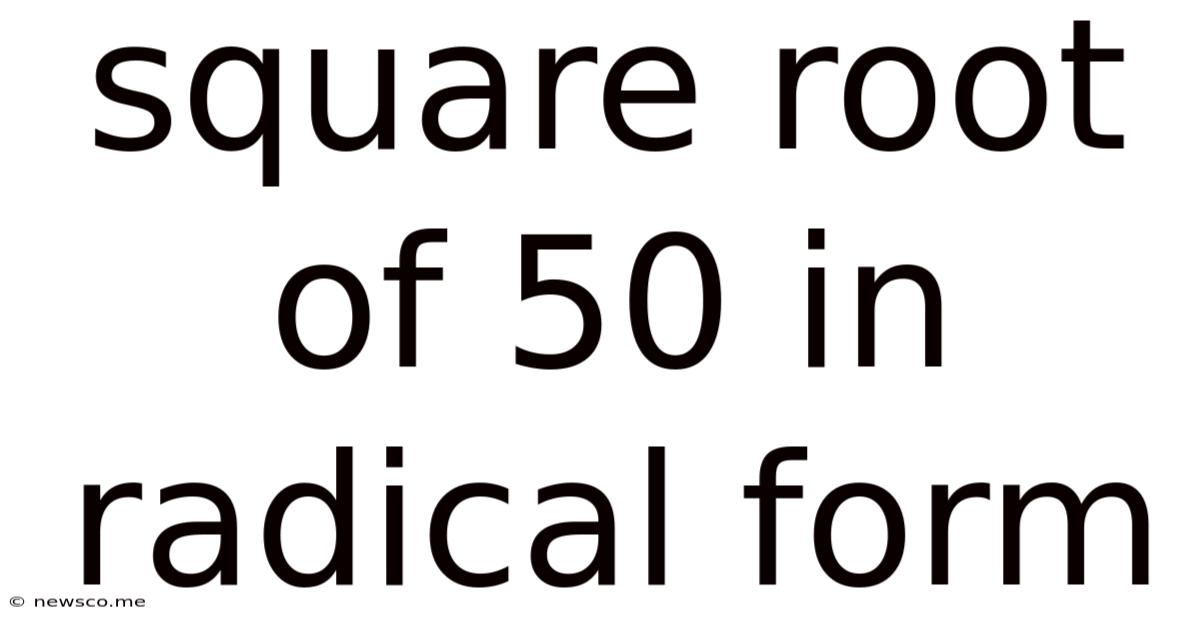Square Root Of 50 In Radical Form
News Co
Mar 15, 2025 · 5 min read

Table of Contents
Understanding the Square Root of 50 in Radical Form
The square root of 50, denoted as √50, is an irrational number. This means it cannot be expressed as a simple fraction and its decimal representation goes on forever without repeating. However, we can simplify it into a more manageable radical form, making it easier to work with in mathematical calculations. This article will delve deep into the simplification process, exploring the underlying principles and providing practical examples. We will also examine its connection to other mathematical concepts and discuss its applications in various fields.
What is a Radical Form?
Before diving into the simplification of √50, let's clarify what we mean by "radical form." In mathematics, a radical form, or surd, is a way of expressing a number using a radical symbol (√). It represents the root of a number. For example, √9 is the square root of 9 (which is 3), and ³√8 is the cube root of 8 (which is 2). A number is in simplest radical form when the radicand (the number under the radical symbol) contains no perfect square factors other than 1.
Simplifying √50: A Step-by-Step Guide
The key to simplifying √50 lies in finding perfect square factors within 50. A perfect square is a number that can be obtained by squaring an integer (e.g., 4 is a perfect square because 2² = 4, 9 is a perfect square because 3² = 9, and so on).
Let's break down the process:
-
Find the prime factorization of 50: We can express 50 as a product of its prime factors: 2 x 5 x 5 = 2 x 5².
-
Identify perfect square factors: Notice that 5² (or 25) is a perfect square factor within the prime factorization of 50.
-
Rewrite the expression: We can now rewrite √50 as √(2 x 5²).
-
Apply the product rule for radicals: The product rule states that √(a x b) = √a x √b. Using this rule, we can separate the expression: √2 x √5².
-
Simplify the perfect square: Since √5² = 5, our expression simplifies to 5√2.
Therefore, the simplest radical form of √50 is 5√2.
Why Simplify Radicals?
Simplifying radicals isn't just about aesthetics; it serves several crucial purposes:
-
Accuracy: Simplified radicals provide a more accurate representation of the number, especially when dealing with calculations that involve irrational numbers. Using the decimal approximation of √50 (approximately 7.071) can introduce rounding errors in complex calculations.
-
Efficiency: Simplified radicals make calculations more efficient. Multiplying 5√2 by another radical is significantly easier than multiplying 7.071 by another number.
-
Clarity: Simplified radicals offer a clearer and more concise way of expressing numerical values, improving the readability and understanding of mathematical expressions.
Practical Applications of √50 and Radical Simplification
The square root of 50, and the ability to simplify radicals in general, finds applications in various fields:
-
Geometry: Calculating the length of diagonals in squares and rectangles often involves working with square roots. For instance, if a square has sides of length 5, its diagonal is √(5² + 5²) = √50 = 5√2.
-
Physics: Many physics equations, especially those dealing with vectors and motion, involve square roots. Solving for the magnitude of a vector often leads to expressions requiring radical simplification.
-
Engineering: Civil, mechanical, and electrical engineers frequently use square roots and radical simplification in calculations involving distances, forces, and electrical currents.
-
Computer Graphics: In computer graphics and game development, vector calculations and transformations rely heavily on square root operations and the simplification of radicals for efficient rendering and animation.
Advanced Concepts Related to √50
Understanding the simplification of √50 lays the groundwork for more advanced concepts in mathematics:
-
Rationalizing the Denominator: If √50 appears in the denominator of a fraction, we rationalize the denominator by multiplying both the numerator and denominator by √2 to eliminate the radical from the denominator. This results in a more manageable form for calculations.
-
Complex Numbers: While √50 itself is a real number, the concept of simplifying radicals is crucial when dealing with complex numbers (numbers involving the imaginary unit 'i', where i² = -1).
-
Solving Quadratic Equations: Quadratic equations often involve square roots in their solutions. The ability to simplify these square roots is critical to obtaining a clear and concise answer.
Common Mistakes to Avoid When Simplifying Radicals
While the process of simplifying radicals seems straightforward, there are some common mistakes to watch out for:
-
Incorrect prime factorization: Ensure the prime factorization of the radicand is accurate. Any errors here will lead to an incorrect simplified form.
-
Forgetting the product rule: Incorrect application of the product rule for radicals can result in an incorrect simplification.
-
Improper simplification of perfect squares: Make sure to correctly simplify the perfect square factors identified within the radicand.
Conclusion: Mastering Radical Simplification
The simplification of √50 to its simplest radical form, 5√2, is a fundamental skill in mathematics. Understanding the process of finding perfect square factors and applying the product rule of radicals is essential for accurate and efficient calculations in various mathematical and real-world applications. By mastering radical simplification, you enhance your problem-solving abilities and gain a deeper appreciation for the elegance and power of mathematics. Remember to practice consistently to solidify your understanding and avoid common mistakes. This seemingly simple concept opens doors to more complex mathematical ideas, making it a cornerstone of mathematical literacy. Always strive for accuracy and clarity in your work, and enjoy the journey of unraveling the intricacies of the mathematical world!
Latest Posts
Related Post
Thank you for visiting our website which covers about Square Root Of 50 In Radical Form . We hope the information provided has been useful to you. Feel free to contact us if you have any questions or need further assistance. See you next time and don't miss to bookmark.